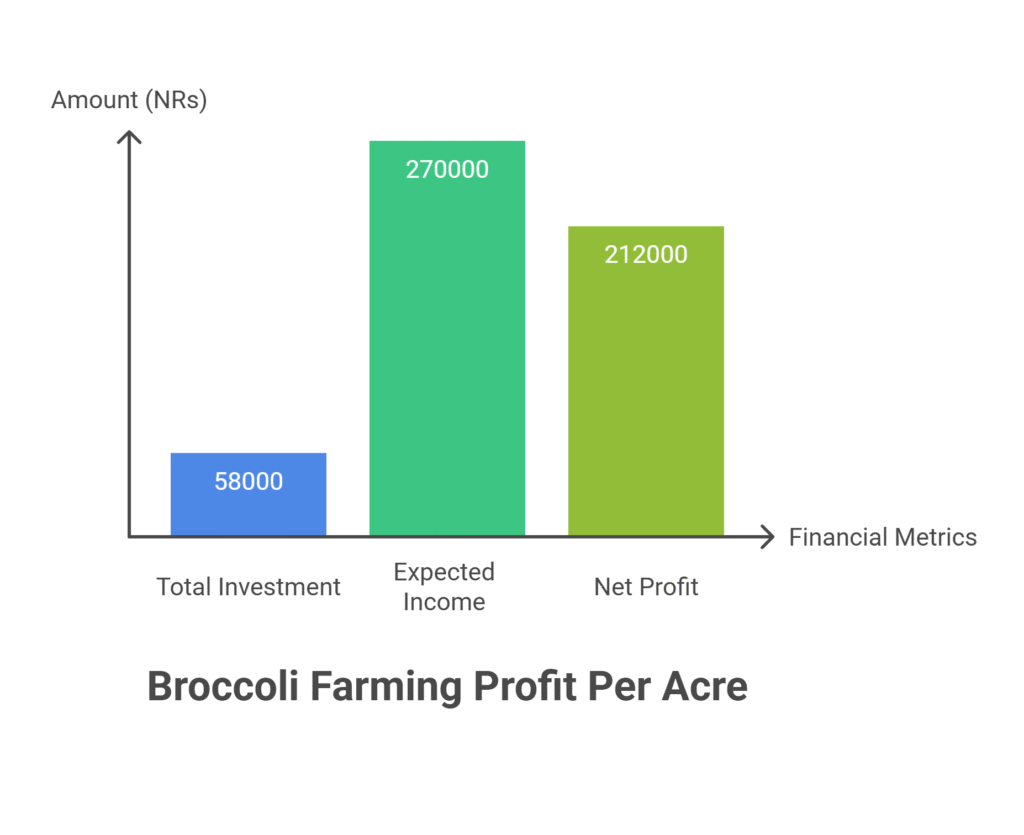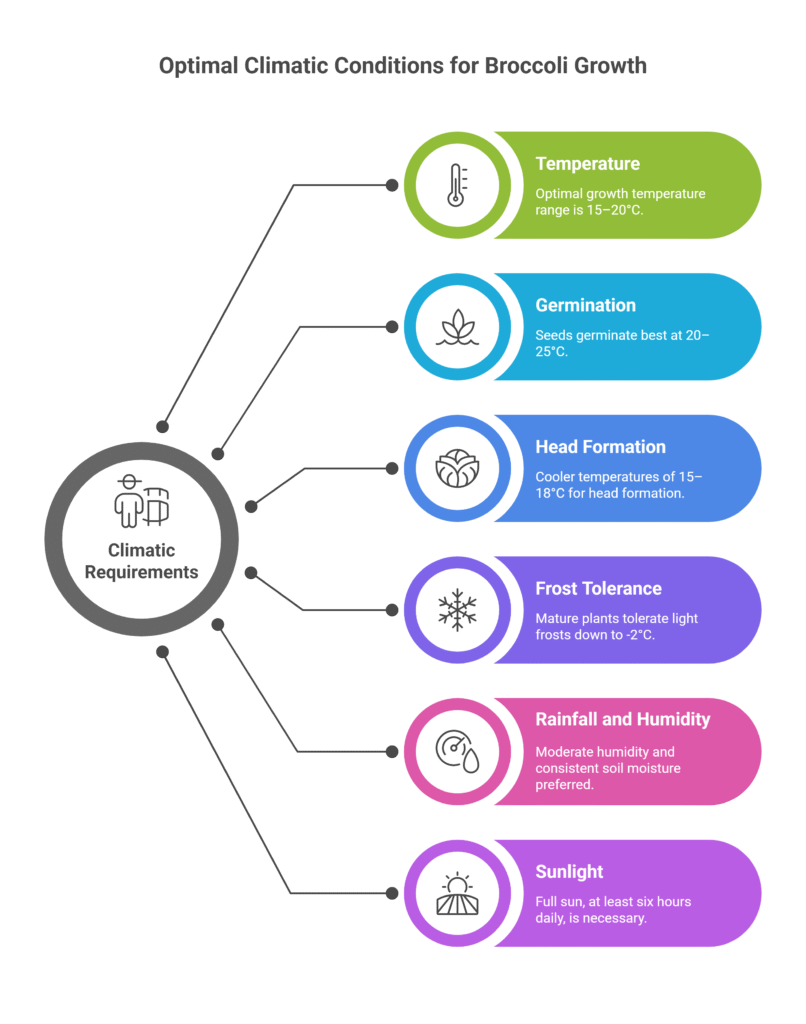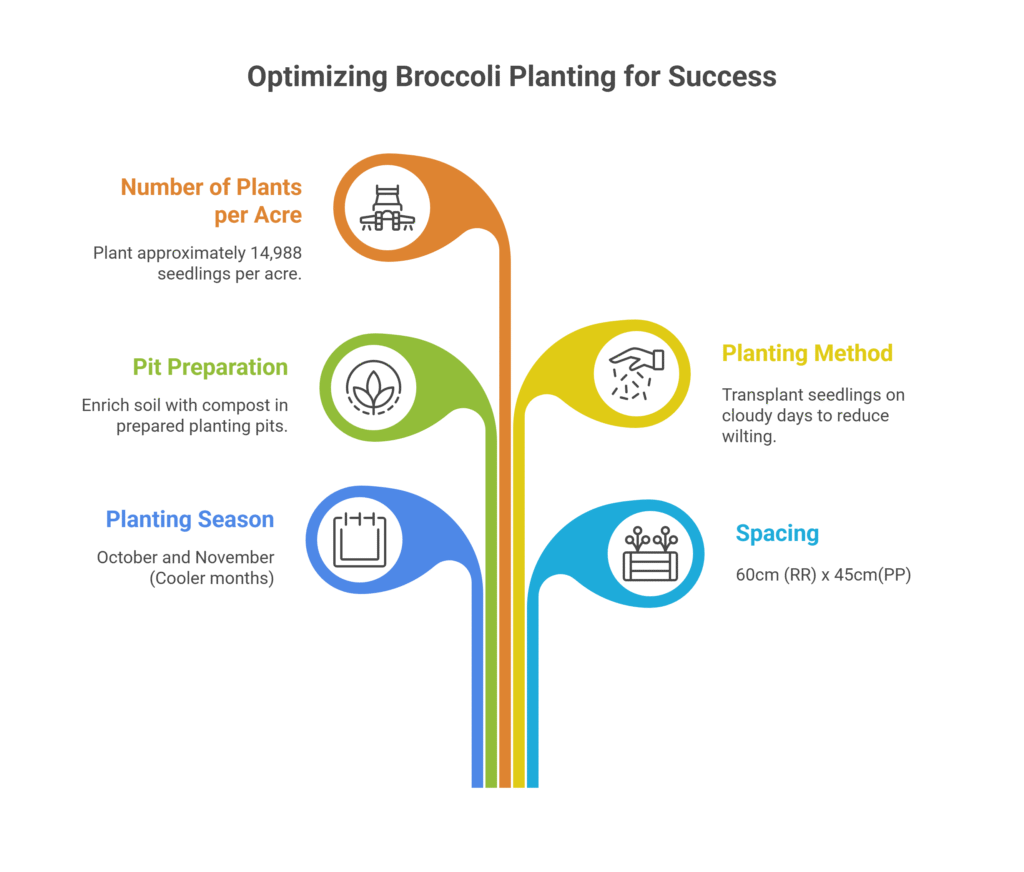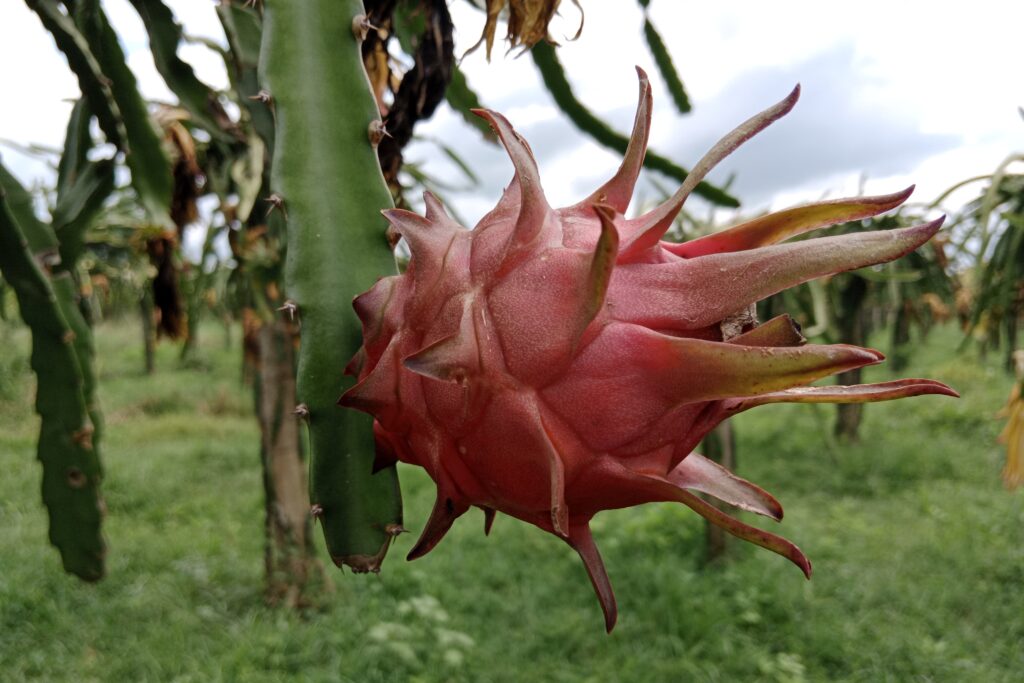Broccoli Farming
A cool-season crop, broccoli (Brassica oleracea var. italica) is recognized for its edible green florets and robust stems. Its abundance of vitamins, minerals, and antioxidants contributes to its popularity in culinary uses, whether served fresh or prepared in dishes.

Broccoli farming profit per acre can be highly lucrative, as shown by a detailed profit analysis. Based on the cost and income calculations, the total investment for one acre of broccoli farming is 58,000 NRs, while the expected income from an estimated yield of 9,000 kg at 30 NRs/kg amounts to 270,000 NRs. This generates a net profit of 212,000 NRs, resulting in a remarkable profit margin of approximately 365.5%, demonstrating the strong earning potential of broccoli cultivation per acre.

Land Preparation
Land preparation begins with creating fine, well-drained, and weed-free seedbed to ensure optimal root development and efficient water management. This involves deep ploughing to a depth of 20–25 cm about 3–4 weeks before planting to expose soil pests, reduce disease incidence, and improve aeration, followed by 2–3 harrowings to break down soil clods and level the field.
During the final harrowing, well-decomposed farmyard manure or compost at a rate of 15–20 tons per acre should be incorporated to enrich soil fertility. Finally, raised beds of 15–20 cm height and 90–120 cm width is prepared, with furrows between them to facilitate irrigation and enhance drainage, particularly in heavy soils or during the rainy season.
Soil Type
The ideal soil for cultivation is deep, fertile, well-drained loamy or silt loam soil enriched with organic matter, with a preferred pH range of 6.0 to 7.0 (slightly acidic to neutral). Maintaining this pH is essential, as levels below 6.0 can cause nutrient deficiencies such as Boron and Molybdenum, while deviations above the range may lead to toxicities. Excellent drainage is crucial to prevent root diseases like clubroot and avoid stunted growth, making poorly drained heavy clay soil unsuitable unless they are thoroughly improved with amendments.
Climatic Requirements
Temperature
Cool-season weather is ideal for this crop. 15–20°C is the optimal temperature range for growth.
- Germination
Seeds germinate most effectively at slightly warmer conditions, with an optimal range of 20–25°C.
- Head Formation
For proper head development, cooler temperatures of 15–18°C are required. Prolonged exposure to temperatures above 25°C often leads to loose or “ricey” heads, buttoning (small and underdeveloped heads), premature bolting, and bitterness.
Frost Tolerance
Tolerance to frost depends on the cultivar. In general, mature plants can withstand light frosts down to -2°C, but severe frost may damage the heads.
Sunlight
Full sun is necessary for strong growth and healthy head formation. Plants should receive at least six hours of direct sunlight daily.
Rainfall and Humidity
The crop prefers moderate humidity with consistent soil moisture. While regular irrigation is essential during dry periods, excessive humidity combined with warm temperatures can encourage foliar diseases.

Major Cultivars
| Category | Subcategory | Description | Example Cultivars |
| Classification | Calabrese Type | most prevalent kind in commerce. A solitary stalk with a large, green center head. Smaller side shoots appear after the primary head is harvested. | Premium Crop, Green Magic, Marathon, Belstar, Gypsy |
| Sprouting Type | Produces many smaller florets on multiple thin stalks instead of one large central head. | Early Purple Sprouting, Late Purple Sprouting | |
| Romanesco Type | Unique chartreuse, spiraled, pointed heads. Valued for visual appeal and nutty flavor. | Veronica | |
| Maturity | Early | 55–70 days from transplanting. Suitable for early market supply. | — |
| Mid | 70–85 days from transplanting. Adapted for main season harvest. | — | |
| Late | 85+ days from transplanting. Chosen for extended or late-season production. | — |
Propagation
Propagation is done almost entirely through seeds, which are initially sown in a protected nursery to produce healthy seedlings before being transplanted into the main field for further growth.
Seed Rate per Acre
The recommended seed rate per acre is typically 200 to 250 grams of good-quality, certified seeds to ensure healthy crop establishment and uniform growth.
Nursery Management
Nursery management involves raising seedlings in protected beds such as raised beds under shade nets or poly tunnels, or in seed/plug trays. Beds should be prepared to a fine tilth by mixing soil with sand and well-rotted compost or FYM, and sterilized if possible, through solarization or chemicals.
Seeds are sown about 1 cm deep, either thinly in rows spaced 5–7 cm apart or broadcast evenly, while in trays, 1–2 seeds are placed per cell. Light, frequent watering using a fine rose can is essential to maintain moisture without waterlogging, and seedlings should be thinned to 2–3 cm apart to avoid spindly growth.
Before transplanting, harden seedlings by gradually exposing them to full sun and wind for 7–10 days to reduce transplant shock. Seedlings are ready for transplanting at 4–5 weeks of age when they have developed 4–6 true leaves.
Planting
a). Planting Season
Sowing is best done during the coolest months, typically October–November and February–March, to ensure optimal growth, while planting should be avoided during hot summer periods and severe winter frosts, as these conditions can hinder seedling development and reduce yield.
b). Spacing
Proper spacing is crucial for achieving optimal head size and ensuring good air circulation, with a recommended distance of 60 cm between rows and 45 cm between individual plants.

c). Pit Preparation
For pit preparation, dig small pits at the selected spacing points and mix a handful of well-rotted compost or FYM with the soil in each pit to enrich it before planting.
d). Planting Method
Seedlings should be transplanted on a cloudy day or late afternoon to reduce wilting, with the nursery thoroughly watered beforehand. Carefully place each seedling in the prepared pit, filling soil around the roots up to the base of the first true leaves to encourage rooting, and gently firm the soil. Water immediately and thoroughly after transplanting to help the seedlings establish.
e). Number of Plants per Acre
Around 14,988 seedlings can be planted per acre when rows are spaced 60 cm apart and plants are spaced 45 cm apart.
Intercropping
Intercropping is best done with short-duration crops that do not compete heavily for light or nutrients, such as lettuce, spinach, radish, onion, and beetroot. This practice allows efficient land use, provides additional income, and can help suppress pests, for example, onions. However, planting other Brassicas like cabbage or cauliflower should be avoided due to shared pests and diseases.
Irrigation
Maintaining consistent soil moisture is critical, especially during head initiation and development, as stress can lead to buttoning or poor-quality heads. Light, frequent irrigations every 3–5 days in dry weather are recommended while avoiding waterlogging.
Drip irrigation is highly preferred for water efficiency, reduced foliar diseases, and fertigation, whereas furrow irrigation is common but less efficient, and sprinklers should be used cautiously due to the risk of foliar diseases. Overhead watering near harvest should be avoided.
Fertilizer and Manure
Soil testing is essential to provide accurate and precise fertilizer recommendations for optimal crop growth.
Table 1: Basal Dose (Applied at Planting)
| Component | Amount per Acre | Example/Equivalent |
| Organic Matter | ||
| Well-rotted FYM/Compost | 15-20 tons | |
| Biofertilizers | ||
| Azospirillum | 1 kg | |
| PSB (Phosphate Solubilizing Bacteria) | 1 kg | |
| Potash mobilizing bacteria | 1 kg | |
| Primary Nutrients | ||
| Nitrogen (N) | 40-50 kg | 90-110 kg Urea |
| Phosphorus (P₂O₅) | 60-80 kg | 375-500 kg SSP (Single Superphosphate) |
| Potash (K₂O) | 40-60 kg | 65-100 kg MOP (Muriate of Potash) |
Table 2: Top Dressing
| Timing & Dose | Component | Amount per Acre | Example/Equivalent |
| 1st Dose: 3-4 weeks after transplanting | Nitrogen (N) | 30-40 kg | 65-85 kg Urea |
| 2nd Dose: Just before head initiation (6-7 weeks after transplanting) | Nitrogen (N) | 30-40 kg | 65-85 kg Urea |
| Potash (K₂O) | 20-30 kg | 35-50 kg MOP |
Table 3: Micronutrients
| Nutrient | Application Form | Amount per Acre | Notes |
| Boron (B) | Borax | 1-2 kg | Apply the first dose of boron as a soil application at transplanting, followed by a second dose as a foliar spray during head initiation to prevent tip burn and enhance head quality. |
| Molybdenum (Mo) | Sodium Molybdate | 0.5 -1 kg | Apply molybdenum as a seed treatment and again early in the vegetative stage. |
Weed Control
Weed control is most critical during the first 4–6 weeks after transplanting. Mechanical methods like shallow hoeing or cultivation should be done carefully to avoid root damage. Mulching with organic materials (straw, dried leaves) or black/silver plastic effectively suppresses weeds, conserves moisture, and moderates soil temperature.
Pre-emergence herbicides such as Pendimethalin can be applied immediately after transplanting, but chemical use must follow label instructions strictly, as post-emergence options for broccoli are very limited. Hand weeding may be necessary to remove any weeds that escape other control methods.
- Inter Culture Operation
Pruning is generally minimal; remove old, yellowing, or diseased lower leaves to improve air circulation and reduce disease pressure. For cultivars that produce side shoots, such as Calabrese, harvest the central head by cutting the stem 5–6 inches below the head to encourage side shoot development, while unwanted side shoots can be pruned if focusing on a single large central head.
Flowering and Fruit Management
In broccoli, the edible portion is the immature flower head, or inflorescence. Effective management focuses on ensuring that these heads develop tightly and compactly, which is essential for market quality. Preventing premature flowering, also known as bolting, is a key aspect, as it can reduce head size and quality.
Bolting is often triggered by environmental stresses such as high temperatures, water stress, or nutrient deficiencies, so maintaining optimal growing conditions—including consistent moisture, adequate fertilization, and proper spacing—is crucial. Timely harvesting at the correct stage, before flowers start to open, also helps maintain the quality and longevity of the crop.
Pest and Disease Management
Common Pests
a) Caterpillars
Broccoli is susceptible to caterpillars such as Diamondback Moth (DBM), Cabbage Looper, and Imported Cabbage Worm. Effective control methods include biological options like Bacillus thuringiensis (Bt) at 2–3 g/L water, Spinosad at 0.1–0.2 mL/L, Neem oil at 2–3 mL/L, and the use of parasitic wasps or pheromone traps. Chemical control can be achieved with targeted insecticides such as lambda-cyhalothrin 5% EC at 10 mL/10 L water or emamectin benzoate 5% SG at 0.5 g/L water, applied carefully following label instructions.
b) Aphids
Common aphids include Green Peach Aphid and Cabbage Aphid. Control methods involve strong water sprays to dislodge them, use of insecticidal soap at 2–3 mL/L, Neem oil at 2–3 mL/L, and encouraging natural predators like ladybugs and lacewings. For systemic control, imidacloprid 17.8% SL at 0.3 mL/L can be used cautiously, ensuring minimal impact on beneficial insects.
c) Whiteflies
Whitefly infestations can be managed using yellow sticky traps, insecticidal soap at 2–3 mL/L, Neem oil at 2–3 mL/L, and biological control agents such as Encarsia spp. Systemic insecticides may be applied if infestations are severe, always following recommended doses.
d) Cutworms
Cutworms attack seedlings at the base. Preventive measures include placing collars around seedlings, using bait traps, and hand-picking at dusk. Insecticides can be applied at planting, such as chlorpyrifos 20% EC at 2 mL/L soil drench, following proper safety guidelines.

Common Diseases
a) Downy Mildew
Yellow dots on the upper leaf surface and purplish mold underneath are the symptoms of downy mildew. Avoiding overhead watering, maintaining adequate air circulation, and planting resistant cultivars are all part of management. Applying Mancozeb 75% WP at 2.5 g/L water, Fosetyl-Al 80% WP at 2 g/L water, or Metalaxyl 8% + Mancozeb 64% WP at 2 g/L every 7–10 days or as directed on the label will provide fungicidal control.
b) Alternaria Leaf Spot
This disease causes dark, target-like spots on leaves. Preventive measures include crop rotation and removal of crop residues. Fungicides such as Chlorothalonil 75% WP at 2 g/L water or Mancozeb 75% WP at 2.5 g/L water can be applied at 7–10-day intervals to manage outbreaks.
c) Black Rot
Black rot presents as V-shaped yellow lesions starting from leaf margins, with blackened veins. Management involves using disease-free seeds, crop rotation of at least 3 years, planting resistant varieties, and avoiding overhead irrigation. Copper-based bactericides such as Copper Oxychloride 50% WP at 2.5 g/L water can be applied preventively or at the first sign of infection.
d) Clubroot
Clubroot causes swollen, distorted roots and stunted plant growth. Control strategies include long crop rotations of 7+ years, liming soil to pH above 7.0, planting resistant varieties, and practicing strict field sanitation. In extreme cases, soil fumigation may be required.
e) Damping-Off (Nursery Stage)
Damping-off leads to seedling collapse in the nursery. Management includes using sterile media, ensuring good drainage, and avoiding overcrowding. Fungicide drenches such as Thiophanate-Methyl 70% WP at 1 g/L water can be applied to prevent the disease.
Harvesting
Harvesting broccoli is essential to preserving its quality. It should be done when the core head is fully formed, compact, tight, and deep green, usually at a diameter of 10 to 15 cm (4 to 6 inches), before the individual flower buds start to enlarge or open.
Handle the heads carefully to prevent bruising and cut the main stem 12 to 15 cm (5 to 6 inches) below the head with a sharp knife. Harvest at the coolest time of the day, ideally early in the morning. Tender 4–6 cm side shoots should be collected every few days for side-shooting types.
Yield
The typical broccoli yield ranges from 8,000 to 12,000 kg (8–12 metric tons) per acre.
Cost of Investment per Acre for Broccoli Farming
| S.N. | Categories | Cost of Investment (NRs.) |
| 1 | Land Preparation (plowing) | 15,000 |
| 2 | Seed | 2,000 |
| 3 | Nursery Management | 5,000 |
| 4 | Transplanting | 5,000 |
| 5 | Fertilizers and Manure | 10,000 |
| 6 | Irrigation | 5,000 |
| 7 | Weed Control (pre & post-emergence) | 3,000 |
| 8 | Pest & Disease Control | 3,000 |
| 9 | Harvesting | 5,000 |
| 10 | Miscellaneous Costs | 5,000 |
| Total Cost | 58,000 |
Income per Acre from Broccoli Farming
| Particulars | Estimated Yield / Acre (Kg) | Market Price (NRs/kg) | Total Income (NRs.) |
| Fresh Broccoli Heads | 9,000 | 30 | 270,000 |
Analysis of Broccoli Farming Profit Per Acre
| Metric | Calculation | Amount (NRs) |
| Total Investment | 58,000 | |
| Total Income | 270,000 | |
| Net Profit | Income – Investment | 212,000 |
| Profit Margin (%) | (Profit ÷ Investment) × 100 | 365.5% |
Crop Calendar for Broccoli Farming (Per Acre Basis)
| Phase | Timing/Duration | Key Activities & Inputs | Special Notes |
| Land Preparation | 30-45 days before planting | Deep ploughing (20-25 cm), 2-3 harrowings, FYM incorporation (15-20 tons), raised bed preparation (90-120 cm width) | Ensure well-drained loamy soil (pH 6.0-7.0) |
| Nursery Sowing | Season 1: Sept Season 2: Jan | Seed sowing (200-250g certified seeds), maintain moisture, seedling hardening (7-10 days) | Use protected beds/trays; seedlings ready in 4-5 weeks with 4-6 true leaves |
| Transplanting | Season 1: Oct Season 2: Feb | Spacing: 60×45 cm (≈15,000 plants/acre), pit preparation with compost, transplant on cloudy days | Avoid frost periods and temperatures >25°C |
| Fertilization | – | Basal (At planting): • FYM: 15-20 tons • N-P₂O₅-K₂O: 40-50-60 kg + biofertilizers (3kg) Top Dressing: • 3-4 WAT: 30-40kg N • 6-7 WAT: 30-40kg N + 20-30kg K₂O | Micronutrients: Borax (1-2kg) & Sodium Molybdate (0.5-1kg) at head initiation |
| Critical Care | 4-7 WAT | • Irrigation every 3-5 days (drip preferred) • Weed control (mulching/pre-emergence herbicides) • Pest/disease scouting | Critical head formation period (15-18°C ideal) |
| Harvest | 55-100 DAT | Harvest when heads are compact (10-15cm diameter), cut stem 12-15cm below head, collect side shoots every 3-5 days | Yield: 8,000-12,000 kg/acre @ market price ≈NRs 30/kg |
Sources
Food and Agriculture Organization (FAO)
University of California Agriculture & Natural Resources (UC ANR)
European Plant Protection Organization (EPPO)
Punjab Agricultural University (PAU)
Tamil Nadu Agriculture University (TNAU) – Agritech portal
Indian Council of Agricultural Research (ICAR)
Nepal Agricultural Research Council (NARC)
U.S. Department of Agriculture (USDA).
Disclaimer: This crop farming profits assume optimal conditions. Actual results may vary depending on climate, market prices, and farm management practices.


